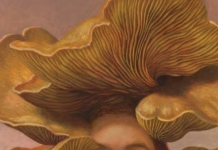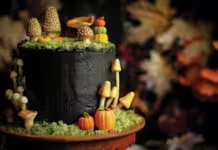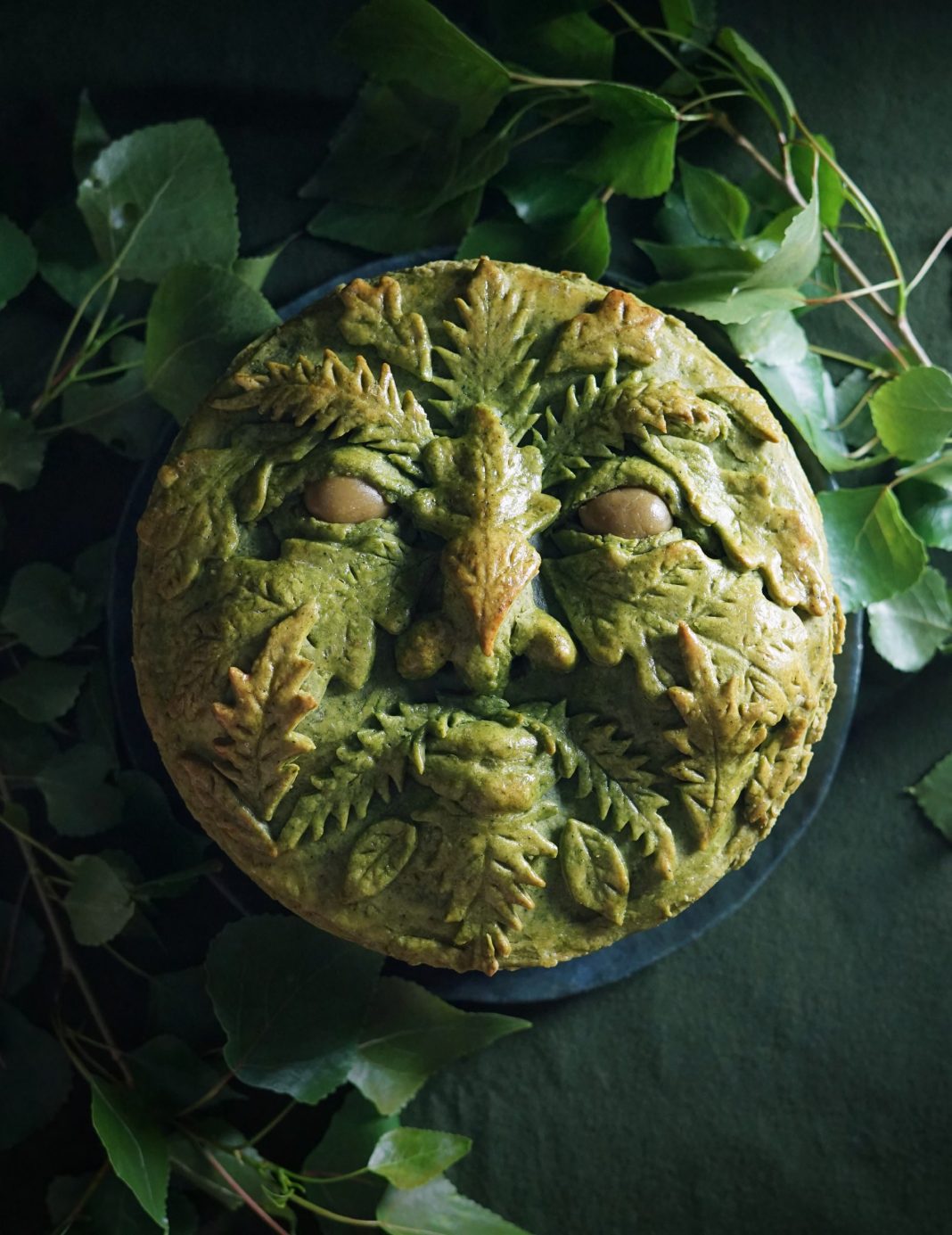Sometimes when you’ve been doing something for a while, it can be easy to forget where you started. Every now and then, someone comes to me who is excited about working with wild plants but unsure where to begin. My advice: Get to know them first.
I think about the wild plants and fungi I know as a sort of community: There are those that are loud and energetic and greet you as you walk through the door, and there are shy wallflowers that I’m still just barely getting to know after many years spent around them. Each plant that I’ve worked with deserves a relationship and a conversation. And funnily enough, that’s often how my knowledge of them progresses.
It starts with a crush. I start noticing a particular plant more and more, start seeing articles about it or recipes pop up, start thinking about it a lot. I get distracted on hikes or drives and feel called to spend more time around it. I begin with research: Where does this plant grow? What parts are edible? Are there any safety considerations or specific ways it
should be processed? Any poisonous look-alikes to be aware of ? How do indigenous people use it? What about herbalists?

Then I harvest a bunch and get to know it. Time to develop a more personal relationship: I might brew up an infusion with just that plant and pay attention to the flavors, the smells, the overall feeling, the way it sits in my body. It’s always good to start low and slow
when introducing a new plant to your body. Just like any other food, there is the possibility of allergy or intolerance. I might then start thinking about flavors: What if I paired this with something acidic? Something sweet? Something salty? (Some of my most successful experiments have come from unexpected combinations, such as candied chanterelle mushrooms or pickled walnuts.) I often make a variety of infusions: vinegar, oil, syrup, and tea, and taste-test each individually before adding them to dishes.
Once I understand the depth of flavor of the plant, I start to compare it with more common food items. This gives me a basis to start brainstorming recipes and researching options. For example, curly dock seed flour is similar to buckwheat, so I might look up buckwheat recipes to adapt. It’s at this point that the infatuation really begins. I start thinking about all the wide possibilities for that particular plant. I do a lot of open-ended experimenting in the kitchen, knowing that some tests will be great and others awful. As I become more and more acquainted with each plant, we become comfortable friends, something I can reach for when I’m looking for a particular flavor profile or texture.
And so begins a beautiful intimacy with the wild plants around my home. I understand rose hips as deeply as I understand tomatoes; I know fir tips like I know basil. It’s through curiosity-driven explorations that I’ve come to develop the knowledge I hold. And just like human friends, I know that I will always have something new to learn from each plant as I continue to explore and converse.
So if you are new to foraging or simply want a way to engage a little bit more deeply, I encourage you to proceed with wonder and curiosity leading the way. Let yourself become infatuated with the plants that you feel drawn to. Explore the depth and beauty they offer. Get to know each one. Then and only then will blending and seasoning with them come as naturally as it does with salt and pepper, as you can see in this wild-flavored picnic pie:

GREEN MAN PICNIC PIE
Many old, nature-based religions saw nature as a representation of the sacred. They believed that all things had a spirit and were part of a greater whole. Shamans and healers would take spiritual journeys into other realms to bring back healing information, given to them by the plants themselves or personifications of them. The Green Man was a symbol of this synchronicity—a communion with the spirit of the wild. He’s both frightening and comforting, just like the true wild: a place of both gentleness and danger. He represents the sacred significance of plants.
The imagery of the Green Man is strangely familiar to most of us. This symbol of a man with leaves branching out of his face has appeared in ancient cultures and in religions all over the world and is called by many names. His origins are a mystery, as we do not know how far back and to what cultures he can be traced. Since he’s appeared in such a vast array of cultures, many believe he is an archetype of our relationship with nature, of both reliance and union with the natural world. He is a symbol of the underlying life force that runs through all of us.
The Green Man is typically associated with the renewed cycle of growth that comes with spring. He represents both new growth and decay, as he can be seen as either emerging from or being reclaimed by nature. He reminds us of our part in the natural world—that we are part of nature’s cycles, not distant from them. Spring is the perfect time to celebrate the lessons he teaches us through a beautiful vegetarian feast of a vegetable-packed picnic pie.
The secret to a successful picnic pie is to precook all the fillings; if there’s too many raw ingredients they will release moisture as they cook, causing a soggy bottom and potential leakage. There are a lot of steps to this pie but most are fairly simple—just roasting or sautéing vegetables. Have fun with the decorations and be creative!

GREEN MAN PICNIC PIE
Filling:
3 cloves garlic
2 medium red onions
2 large zucchinis
¼ cup olive oil
4 purple potatoes
3 cups peas
6 cups baby spinach or young nettles 2 cups ricotta cheese
2 tablespoons chopped fresh mint ¼ cup chopped fresh basil
1 lemon
Salt and pepper
2 green olives
Pastry:
4⅔ cups all-purpose flour
⅓ cups powdered dried nettle or spinach 1 teaspoon salt
½ teaspoon baking powder
1¼ cup unsalted butter
⅔ cup ice-cold water
1 beaten egg, to glaze
3 tablespoons milk
DIRECTIONS
Begin the pastry: Sift the flour, spinach or nettle powder, salt, and baking powder into a large mixing bowl. Cut in the butter and rub until the mixture looks like fine crumbs. Stir in enough cold water to make a firm but not stiff dough. Divide the dough into two equal parts. Lightly knead each half until smooth, then form into a ball and wrap in plastic wrap and chill for 20 minutes.
Meanwhile, prepare your vegetables: Preheat the oven to 400°F. Slice the onions thinly, peel and slice the garlic into thin slices, slice the zucchinis lengthwise, and peel the potatoes and slice them into half-inch slices.
Place the potato slices on a baking tray and drizzle with olive oil and season with salt and pepper. Add the zucchini slices, also drizzled with olive oil and seasoned with salt and pepper. It’s best to keep the vegetables separate. Cook until everything is tender, about 20 minutes.
Meanwhile, heat a large pan over medium-high heat. Cook the onions for about 10 minutes, or until caramelized. Add the garlic and sauté until cooked, then remove from heat.
Cook the peas in a small pan over medium heat until they are soft. Roughly mash with a fork and mix in the mint.
Bring a pot of water to boil and dump in the spinach or nettles, then immediately strain it out. Let it cool, then squeeze it dry and chop it up.
Add the ricotta to the spinach and mix well. Grate in lemon zest from one lemon and mix in well. Add the chopped basil and salt and pepper to taste.
After chilling, roll the dough out on a lightly floured table to just over a quarter-inch thick. Press into the cake pan, pushing out any wrinkles or air bubbles. Make sure there are no tears or holes; you can press more dough into any areas that look thin or broken.
Preheat your oven to 350°F with a baking sheet inside. Fill the pie by first placing a layer of purple potato slices, then half of the ricotta-nettle mixture. Top with the zucchini slices, then the pea puree. Add the red onions. Spread the rest of the ricotta mixture and top with more potato slices. Place two slices on the top of the layer where the cheeks will be, and a smaller slice for the chin. Cut a long triangle out of another piece for the nose. This gives some depth to the decorations in the next step. Make sure to pack the fillings in there well, removing any pockets of air.
Decorate the pie: Roll a thin layer of the remaining dough out and cover the top. You should see some lumps where the nose, chin, and cheeks are. Place the green olives for the eyes, then cut out some thin crescent-shaped pieces of dough to place around them to look like eyelids. Glue in place using a little bit of the milk brushed on. Sculpt a nose out of some more of the dough and place on the pie, poking small air holes inside the nostrils. Again, use milk to attach it. Sculpt lips out of small tapered snakes of dough and attach them as well. Cut leaf shapes out of the remaining dough, rolled fairly thin, and impress veins on them with the back of a butter knife. Glue in place. Make sure none of the leaves are overlapping the pan’s edge, otherwise it will be difficult to remove the pan without breaking them off. Once you’re happy with your decorations, beat the egg with a tiny bit of water until smooth and brush the top of the pie with the mixture, reserving some for later.
Bake your pie at 350°F on the preheated baking sheet for 30 minutes, then cover the top with tinfoil and cook for another 30 to 40 minutes. Remove the cooked pie from the oven and leave to cool and firm up for 20 minutes before carefully removing the cooking mold and placing the pie on a cookie sheet. Brush the sides with beaten eggs to glaze, then return it to the oven to bake for another four to five minutes until golden and shiny.
Remove and leave to cool, then transfer to a serving plate.
The Green Man is typically associated with the renewed cycle of growth that comes with spring. He represents both new growth and decay, as he can be seen as either emerging from or being reclaimed by nature.
































